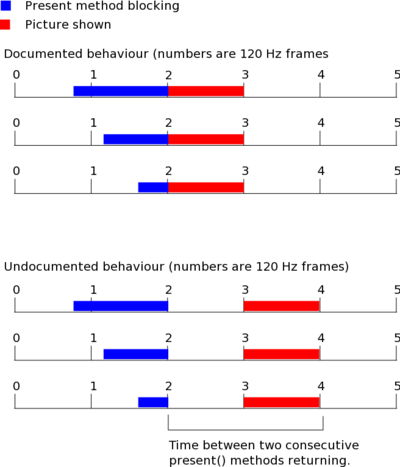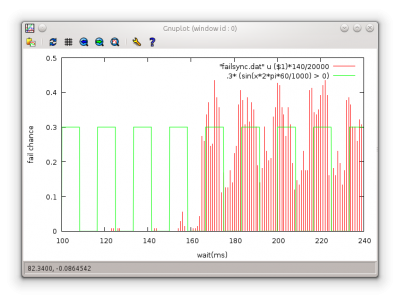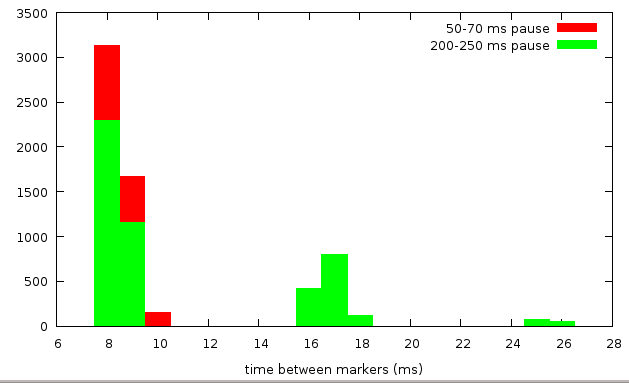|
|
| Line 1: |
Line 1: |
| − | {{Infobox software | + | {{see also|Presentation}} |
| − | | name = Presentation
| + | This page documents some bugs we encountered in Presentation. Users should go to the [[Presentation]] page. |
| − | | logo = Presentation_name.png
| |
| − | | logo size = 200px
| |
| − | | logo alt = Presentation | |
| − | | screenshot =
| |
| − | | caption =
| |
| − | | developer = Neuro Behavioral Systems
| |
| − | | installed version = varies <ref>See [[Pre-installed software]]</ref>
| |
| − | | installed version date = <!-- {{Start date and age|YYYY|MM|DD|df=yes}} -->
| |
| − | | platform = Windows
| |
| − | | language count =
| |
| − | | website = [https://www.neurobs.com/ neurobs.com]
| |
| − | | resources =
| |
| − | {{Infobox tsg
| |
| − | | child = yes
| |
| − | | downloads = {{bulleted list
| |
| − | | [[media:Presd172081114.zip|Installer for Windows (32-bit, zip)]]
| |
| − | | [[media:Presd181020115_64.zip|Installer for Windows (64-bit, zip)]]
| |
| − | | [https://www.neurobs.com/menu_presentation/menu_download/package_player Package player]
| |
| − | }}
| |
| − | | header2 = Templates
| |
| − | | data2 = *[[media:Template2014.zip|Template 2014 (zip)]]
| |
| − | }}
| |
| − | }}
| |
| − | | |
| − | Presentation is a Windows based programming tool that allows experimenters to set up and program all sort of experiments. It is the recommended software for time-accurate experiments and therefore supported by the institutes’ (Social Sciences Faculty, the MPI and the Donders Centre for Cognitive Neuroimaging) technical groups. The technical groups offer (PhD) students a couple of pre-programmed experiments (i.e. templates), which can be adjusted to build up own experiments. In this way, the (PhD) student can efficiently program experiments fitting an technical optimal environment. This is what this course is all about. It aims at teaching programming skills, which are needed to modify the existing templates such that they meet your own demands. Because this can be quite complex, we start with short assignments, which address one basic and simple problem at a time. They will all contribute to the final assignment in which you will work on an existing template.
| |
| − | <br/>
| |
| − | | |
| − | == Course ==
| |
| − | | |
| − | Find the presentation workshop documentation here: [[Media:Programming with Presentation 2013.pdf]]
| |
| − | | |
| − | Find the presentation pre-reader here: [[Media:Presentation pcl pre-read 2013 .pdf]]
| |
| − | | |
| − | == License ==
| |
| − | | |
| − | To run presentation in the labs you need a software dongle. Reserve a dongle when you book a lab. If you need a dongle for research outside the university you could discuss time limits with Ronny Janssen.
| |
| − | | |
| − | When you want to run in your office use the network license. Boot presentation, choose option '''"activations" -> "Network"'''
| |
| − | | |
| − | Fill in the following within the "'''Network License Settings"''':
| |
| − | | |
| − | | |
| − | {| class="wikitable"
| |
| − | |-
| |
| − | ! Enable Hostname:
| |
| − | | lic-pres.socsci.ru.nl
| |
| − | |-
| |
| − | ! Port:
| |
| − | | 1245
| |
| − | |-
| |
| − | ! Timeout (ms):
| |
| − | | 5000
| |
| − | |-
| |
| − | |}
| |
| − | | |
| − | [[File:PresentationLicentie.jpg | 700px ]] | |
| − | | |
| − | == Video ==
| |
| − | Presentation only supports non-proprietary video formats.<ref>https://www.neurobs.com/menu_support/menu_forums/view_thread?id=8785#i6</ref> Neurobs recommends encoding your videos using h264 or XVID, and using the AVI format.<ref>http://www.neurobs.com/wiki/Presentation/Video</ref> The TSG discourages the use of XVID and AVI, because these standards have become obsolete in recent years, but since we have had little success getting alternative non-proprietary video formats to work in Presentation,<ref>[[Video_Codecs#Software_support]]</ref> it seems the use of AVI is inevitable. You can find more information on how to export and convert your videos for Neurobs Presentation on our [[Video Codecs#Neurobs Presentation|Video Codecs page]].
| |
| − | | |
| − | == Troubleshooting ==
| |
| − | | |
| − | ==== Version History ====
| |
| − | | |
| − | For version history please click here: http://www.neurobs.com/menu_presentation/menu_download/version_history
| |
| − | | |
| − | ==== Fixed Bugs ====
| |
| − | | |
| − | For fixed bug / known bugs please click here: http://www.neurobs.com/menu_support/menu_help_resources/known_bugs
| |
| − | | |
| − | ==== Forum ====
| |
| − | | |
| − | For various information please click here: http://www.neurobs.com/menu_support/menu_forums/contents_page
| |
| − | | |
| − | ==== Wiki ====
| |
| − | For the wiki click here: http://www.neurobs.com/menu_support/nbs_wiki
| |
| − | | |
| − | ==== Compatibility Issues ====
| |
| − | | |
| − | *Always check beforehand in which version the script was written.
| |
| − | *New versions do not always maintain backwards compatibility.
| |
| − | *Features can get removed, or changed.
| |
| | | | |
| | == Screen synchronization issue on 120 Hz screens == | | == Screen synchronization issue on 120 Hz screens == |
This page documents some bugs we encountered in Presentation. Users should go to the Presentation page.
Screen synchronization issue on 120 Hz screens
There is a serious synchronization issue where the picture.present() method returns one frame too early. It can be detected by measuring the time between two consecutive present() calls returning:
wait_interval(220);
picture1.present();
int t0 = clock.time();
picture2.present();
int t1 = clock.time();
int dt = t1-t0;
One would expect picture1 to be shown for 1 frame (1/120 s) and time dt to show this. Sometimes this is not the case. The image will be shown for one frame (1/120 s), but dt will be 2/120 s:
The fact that picture1 is shown for only 1/120 s was confirmed with a light sensor connected to an oscilloscope.
The chance of this issue occurring is highly dependent on the waiting time prior to the first present() call:
Neurobs people seem to think it has something to do with triple buffering, but the graph above was created without triple buffering enabled.
References


